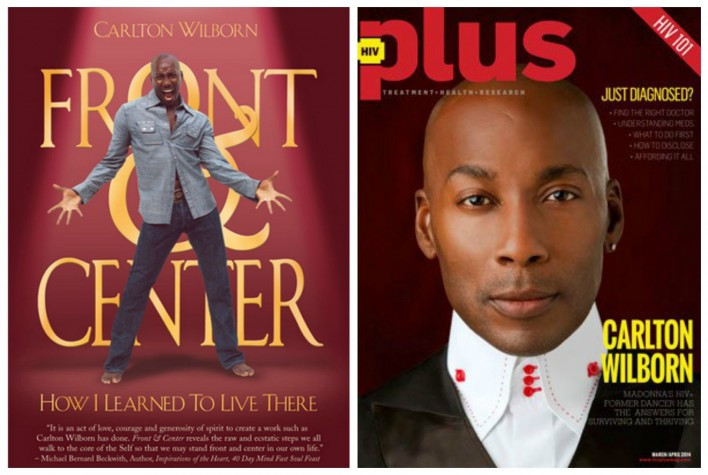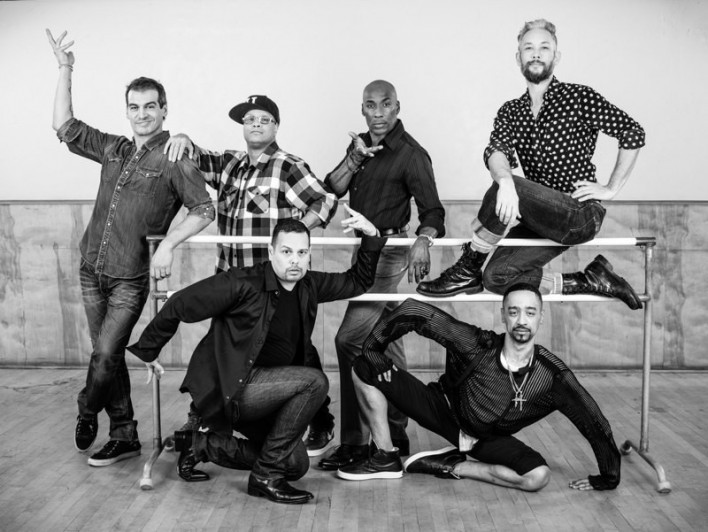Carlton Wilborn, a name synonymous with captivating dance and profound personal strength, is perhaps best recognized as the charismatic “Carlton Dancer” who graced Madonna’s groundbreaking 1990 “Vogue” music video. Beyond this iconic moment, Wilborn’s dynamic presence illuminated both the Blond Ambition and Girlie Show tours, solidifying his place in pop culture history. In 2007, he unveiled a deeply personal narrative in his award-winning autobiography, Front & Center: How I Learned to Live There, sharing his journey of living with HIV since 1985 amidst a life dedicated to art and self-expression.
His story takes another poignant turn in the documentary Strike a Pose, a film that revisits the lives of Madonna’s Blond Ambition tour dancers as they navigate the complexities of life after global fame. The documentary reveals the hidden realities faced by Carlton, Gabriel Trupin, and Salim “Slam” Gauwloos, all of whom were living with HIV during the Blond Ambition tour in the early 90s, a secret they guarded even from each other. While Gabriel tragically passed away from AIDS-related illness in 1995, Slam courageously shared his status during the filming of Strike a Pose. Carlton’s established openness about his HIV status, predating the film, positions him as a long-term advocate, contrasting with Slam’s more recent public acknowledgment.
Carlton’s artistic pursuits extend beyond dance. His acting talents garnered a GLAAD Award nomination for his portrayal of a transgender character in The Mentalist, and he starred in the Lifetime movie Troubled Child. Further showcasing his commitment to personal growth and empowerment, he founded Danceformation, a life-coaching workshop designed to inspire and transform lives. While Strike a Pose touches upon the dancers’ struggles, it only partially captures the breadth of Carlton’s post-Madonna achievements and his ongoing work in advocacy and personal development. However, the film’s raw honesty and the enduring appeal of the dancers themselves resonate deeply, offering a compelling glimpse into their lives.
For many viewers, Strike a Pose offers a chance to reconnect with figures who were once at the forefront of pop culture. For Carlton, and for audiences alike, the film and subsequent discussions provide an opportunity to reflect on a remarkable journey spanning three decades of the AIDS epidemic and personal evolution.
Navigating the Beginning: An HIV Diagnosis in 1985
Carlton’s journey with HIV began with a diagnosis in 1985, a period marked by significant stigma and fear surrounding the virus. He candidly admits to having been “an active homophobe” in his earlier years, reflecting the internal conflicts and societal pressures of the time. His sexual exploration led him to relationships with both women and men, experiences he describes as fraught with internal discomfort and secrecy. While touring with the Hubbard Street Dance Company, a lingering illness prompted a medical visit that would change his life. The unexpected news of his HIV positive status delivered in Hawaii was, in his words, a profound shock.
The Weight of Silence: Sharing and Withholding the Truth
In the immediate aftermath of his diagnosis, Carlton faced the difficult decision of whom to confide in. He selectively shared his status, informing two girlfriends and a few male partners. However, his family remained unaware until the publication of his autobiography in 2007. This period was characterized by “constant scrambling,” a testament to the emotional burden of living with a secret in a time of widespread misunderstanding and prejudice surrounding HIV.
From Fear to Freedom: Embracing Openness
In Strike a Pose, Carlton delivers a powerful monologue reflecting on the debilitating effects of concealing his HIV status, describing feelings of “ramped up fear and hatred” and a sense of living a fabricated life. His journey towards openness began with his 2007 autobiography, a conscious effort to bring his private struggles into the public light. This marked the initial step in a gradual process of self-acceptance and advocacy.
A pivotal moment in this journey occurred with HIV Plus magazine’s request for an article, which then evolved into an offer for a cover feature. Despite having shared his story in his book, the prospect of placing his face so prominently in association with HIV presented a new level of vulnerability. Yet, he embraced the opportunity.
The Transformative Power of Visibility
Carlton describes the release of the HIV Plus issue as a “phenomenal” and “organic, shifting moment.” Encountering the magazine at his pharmacy, seeing his face and name boldly displayed, evoked feelings of gratitude and liberation. The “old shit” of shame and secrecy dissolved, replaced by a sense of empowerment.
Further reinforcing his commitment to openness was the Strike a Pose production team’s request to film at his doctor’s office. This proposition mirrored the pivotal decisions he faced when writing his book and considering the magazine cover. Each instance presented a choice: to remain confined by fear or to embrace freedom and potentially help others by sharing his truth.
Watching “Strike a Pose,” I was able to clearly see that I’m on the other side of the regret and shame.
“Strike a Pose” and the Shifting Landscape of AIDS Awareness
Strike a Pose invites a comparison between the heightened AIDS awareness of the “Truth or Dare” era and contemporary society. Carlton observes a noticeable decrease in public discourse surrounding HIV today compared to the intense period of his diagnosis in the 80s and early 90s. While acknowledging the positive aspects of reduced stigma and advancements in treatment, he also reflects on the profound impact of that earlier era. It was a time when individuals with AIDS were often marginalized and dehumanized. Navigating this societal context while striving to succeed as a performer demanded immense resilience and a refusal to internalize negative narratives.
The documentary and the present moment, in stark contrast to the Truth or Dare timeline, signify freedom for Carlton. The “hiding and self-hatred” that once defined his experience are no longer present, allowing him to fully embrace “moments of goodness.”
Life Coaching and the Wisdom of the “Well Period”
Beyond his dance career and advocacy work, Carlton is a life coach, or as he describes himself, a “transformational empowerment teacher” through his platform LivingFrontAndCenter.com. His book delves into the concept of “the well period,” the challenging low points in life that, paradoxically, can be catalysts for profound growth. This concept resonates deeply with the narratives in Strike a Pose, where many dancers, including Luis with his struggles with addiction, have navigated significant hardships.
Carlton explains the “well period” as a time when life contracts, forcing a focus on what truly matters. Rather than diminishing one’s sense of self, it compels reinvestigation of personal values and truths. The “well period” serves a constructive purpose, offering opportunities for self-discovery and transformation, provided one avoids becoming trapped by temporary setbacks.
The “Well Period” of Living with HIV
When asked about his own “well period,” Carlton identifies his entire journey with HIV as a prolonged period of profound learning and transformation. He now feels he has emerged “on the other side” of this challenging phase.
 Carlton Wilborn’s journey of self-expression includes his autobiography and his willingness to share his story on the cover of HIV Plus magazine, demonstrating his commitment to open dialogue and advocacy.
Carlton Wilborn’s journey of self-expression includes his autobiography and his willingness to share his story on the cover of HIV Plus magazine, demonstrating his commitment to open dialogue and advocacy.
Shared Journeys and the Power of Disclosure
A significant element of Strike a Pose is the inclusion of Slam’s HIV story. His recent decision to publicly share his status provides a powerful parallel to Carlton’s long-standing openness, allowing for a comparative view of their individual journeys. For Carlton, witnessing Slam’s disclosure in the film offered a profound realization of his own progress, reinforcing the “grace of where my life is now” and his distance from past “regret and shame.” Initially anticipating that he would be the sole voice on HIV within the documentary, he found empowerment in sharing the platform and advocating for empowerment alongside Slam.
Navigating Early Treatments and Finding Balance
Slam’s narrative touches upon his initial denial and eventual hospitalization in 1997, leading to the adoption of new HIV medications. Carlton’s experience with treatment began immediately after his 1985 diagnosis. He started with early medications like AZT and ddI, navigating the complexities of early HIV treatment when medical understanding was still evolving.
The Challenges of Early Medications and Holistic Approaches
Carlton candidly describes the “extreme reactions” he experienced with early medications. The process of finding a tolerable and effective treatment regimen involved trial and error. He even considered “drug holidays,” a now-discredited practice of temporarily discontinuing medication. Despite fluctuating viral loads and CD4 counts, Carlton maintained a seemingly healthy state, baffling his doctors. His doctor repeatedly questioned him about this anomaly, seeking to understand the factors contributing to his well-being.
Carlton attributes his resilience to a “spiritually proactive” approach, emphasizing meditation, a positive outlook, and actively minimizing negative influences in his life. He describes himself as “a God person,” highlighting the role of faith in his journey. After struggling with various medication combinations, he recounts a moment of surrendering to faith, which he believes led to the discovery of a successful treatment regimen in 2004 that has maintained an undetectable viral load ever since.
His approach to health integrates Western medicine with Eastern philosophies. He actively engages in dialogues with his doctor, sharing readings and videos to foster a collaborative and holistic approach to his care. This proactive engagement underscores his belief in patient agency and the importance of questioning and participating in medical decisions.
HIV, at least today, is an issue wrapped around self-love and self-care.
Contemporary Challenges in the Fight Against HIV
Reflecting on the current landscape of the HIV epidemic, Carlton points to both progress and emerging challenges. The availability of effective treatments, including medications for those living with HIV and PrEP for prevention, has ushered in a “different kind of freedom.” However, he cautions against complacency, emphasizing the need for continued vigilance.
He also highlights the pervasive influence of social media and its potential impact on self-perception and behavior. The pressure to seek external validation through social media platforms can, in his view, detract from self-honoring choices and contribute to a cycle of seeking external approval. Carlton argues that “the whole issue with HIV, at least today, is an issue wrapped around self-love and self-care.” Prioritizing self-respect and self-care is, in his perspective, fundamental to fostering healthy relationships and responsible behavior.
A Message of Hope and Resilience
In closing, Carlton offers a powerful message of hope. “Without sounding like a Hallmark card, hope is effective,” he states. He underscores the importance of maintaining hope, even in the face of adversity, and emphasizes the critical roles of faith, hope, and resilience in navigating life’s challenges. For Carlton, fostering “energies of strength” is essential for personal well-being and for supporting others.
To delve deeper into the stories of Madonna’s Blond Ambition dancers, read “Madonna’s Blond Ambition Dancer ‘Slam’ Is ready to Talk About His HIV—Just Don’t Ask Him to Vogue.”
 The dancers of Madonna’s Blond Ambition tour, captured in “Strike a Pose,” showcase enduring bonds and individual journeys. Pictured top row: Salim “Slam” Gauwloos, Oliver Crumes III, Carlton Wilborn, Kevin Stea; bottom row: Luis Camacho, Jose Gutierez.
The dancers of Madonna’s Blond Ambition tour, captured in “Strike a Pose,” showcase enduring bonds and individual journeys. Pictured top row: Salim “Slam” Gauwloos, Oliver Crumes III, Carlton Wilborn, Kevin Stea; bottom row: Luis Camacho, Jose Gutierez.
